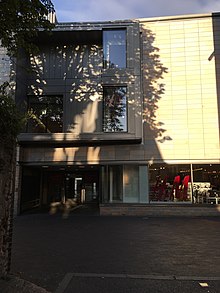
Cornmarket Street is a major shopping street and pedestrian precinct in Oxford, England that runs north to south between Magdalen Street and Carfax Tower.

Allders was an independent department store operating in the United Kingdom.
TK Maxx is a subsidiary of the American apparel and home goods company TJX Companies. The stores operate throughout the United Kingdom, Australia, Ireland, Germany, Poland, Austria and the Netherlands, totalling 629 stores in Europe and 56 in Australia in May 2020. In Poland, there are a total of 44 stores. The chain uses a slightly different name from that of the TJ Maxx stores in the United States, to avoid confusion with the British retailer T. J. Hughes.

Southside Wandsworth is a shopping centre in the district of Wandsworth in London, England. When it was built it was the largest indoor shopping centre in Europe and is currently the fifth largest indoor shopping centre in London after Westfield Stratford City, Westfield London, the Whitgift Centre and Brent Cross Shopping Centre.

Lewis's is a online retailer and homeware brand. It was also a chain of British department stores that operated from 1856 to 2010. The owners of Lewis's went into administration several times, including in 1991. The first store, which opened in Liverpool city centre, became the flagship of the chain. Several stores in the chain were bought in 1991 by the company Owen Owen and continued to operate under the Lewis's brand name for several years, but after the closure of the Manchester store in 2001, only the original Liverpool store continued to trade under the Lewis's name. This store was sold in 2007 to Vergo Retail Ltd and closed in 2010.

The Haymarket Shopping Centre is a shopping centre in the city centre of Leicester, England. It was opened on 4 June 1973 as part of the Haymarket Centre and was the country's second shopping centre after the Bull Ring, Birmingham. It is located east of and adjacent to the Clock Tower.
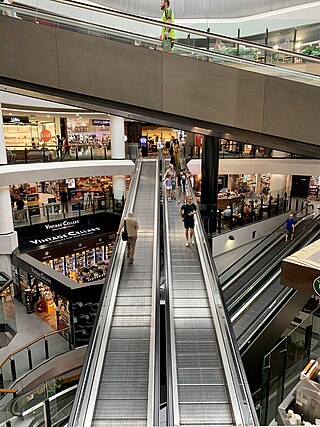
Toowong Village is a highrise building situated at the centre of the Brisbane suburb of Toowong, Queensland, Australia, on the block of land bounded by Coronation Drive, High Street and Sherwood Road. The blue glass office tower is a prominent landmark visible from Toowong and surrounding suburbs.

Westfield Hornsby is a large indoor/outdoor shopping centre in the suburb of Hornsby on the Upper North Shore of Sydney.

The Headrow is an avenue in Leeds city centre, West Yorkshire, England.

Cascades Shopping Centre is an enclosed shopping centre in the city centre of Portsmouth on the South Coast of England. It has a wide range of High Street retailers, and its own multi-storey car park connecting straight into the malls by lifts and stairs. Work began on the Centre in Summer 1987 and it opened on 26 September 1989.
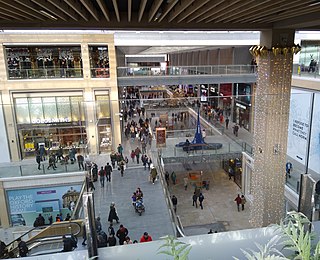
Westgate Oxford is a major shopping centre in Oxford city centre, England, that was extensively remodelled and extended between 2016 and 2017.
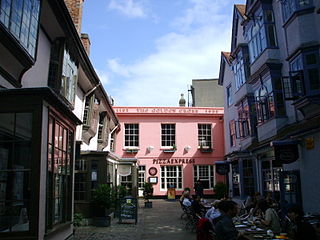
Golden Cross is a shopping arcade at 5 Cornmarket Street in central Oxford, England. The original structure on the site dates from 1193, when it was called Maugershall after the then owner, and consisted of shops with an inn on the upper storeys. The building structures now on the site date from the late 15th century, when they were used as a traditional coaching inn, as is clear from its layout and historical documents. The collection of historic buildings in the Golden Cross courtyard to the east off Cornmarket Street, one of Oxford's main shopping streets. Golden Cross is now used as Oxford's branch of Pizza Express. The courtyard is used as a thoroughfare which leads to the historic Covered Market and has been redeveloped as a small shopping centre, with upmarket shops, a branch of iGlasses Opticians, Holland and Barrett and a Chinese herbalist.

Boswells of Oxford was the largest independent family-run department store in Oxford, England. The store closed in 2020.

Brookside Shopping Centre is the largest shopping centre in Brisbane's north-west, situated in Mitchelton, a suburb of Brisbane, Queensland, Australia.
The Glen Shopping Centre is a major regional shopping centre located in Glen Waverley, Victoria, Australia. The head offices of MYOB are located in the centre.

The Queensgate shopping centre is located in the centre of the UK city of Peterborough, in Cambridgeshire. It contains over 100 stores and parking for 2,300 cars in four onsite multi-storey car parks. Queensgate bus station is located within the shopping centre and only a short walk from Peterborough railway station. Peterborough Shop Mobility provide wheelchairs and electric scooters to help those with limited mobility. The centre was opened by Queen Beatrix of the Netherlands on 9 March 1982.

Top Ryde City is a large indoor/outdoor shopping centre owned by The Blackstone Group. It is located in the suburb of Ryde in Northern Sydney.
William Abel Pantin was a historian of medieval England who spent most of his academic life at the University of Oxford.
Lidcombe Shopping Centre is a shopping centre in the suburb of Lidcombe in Greater Western Sydney.
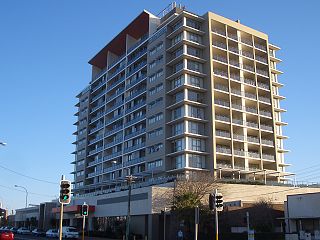
Southpoint Shopping Centre is a shopping centre in the suburb of Hillsdale in the Eastern Suburbs of Sydney, Australia, south-east of the CBD.




